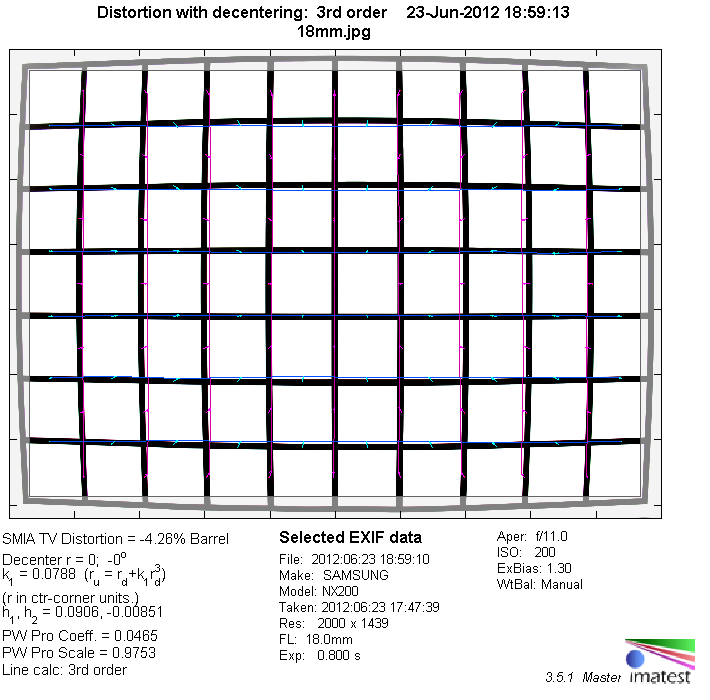|
Samsung NX 18-200mm f/3.5-6.3 ED OIS iFn ( EX-L18200MB ) - Review / Test Report - Analysis |
|
Lens Reviews -
Samsung NX
|
|
Page 2 of 3

Distortion
The distortion characteristic follows the usual pattern in this lens class. The lens produces heavy barrel distortion (4.3%) at 18mm. In the middle range there's nothing to worry about in this respect and there is only a slight amount of pincushion distortion from the mid to long end.
Please note that this is the native distortion characteristic of the lens. The system features a auto-distortion correction so if you are choosing straight JPEGs or take advantage of the default correction in CaptureOne (Samsung's RAW converter) there's little to worry about here.
|
Move the mouse cursor over the focal length text marks below to observe the respective distortion
|
| 18mm |
24mm |
50mm |
100mm |
200mm |
|

|
Vignetting
The Samsung NX lens shows some light falloff at max. aperture with an expected peak at 18mm @ f/3.5. At ~1.2EV (f-stops) this will be visible in some scenes but stopping down a little reduces the issue to a very acceptable 0.5EV. The amount of vignetting decreases at max. aperture the more you zoom out to the middle range before increasing slightly towards the very long end.
The provided figures show the native vignetting characteristic. When using distortion auto-correction some of the edge portion is cropped so the vignetting is a somewhat lower then. However, basically this makes a real difference at 18mm @ f/3.5 only (down to 0.75EV from ~1.2EV).

MTF (resolution)
We didn't really expect wonders from the Samsung NX 18-200mm f/3.5-6.3 ED OID iFn in terms of resolution but we got somewhat disappointed nonetheless. The performance is actually very fine at 18mm. The image corners are somewhat soft at f/3.5 but at medium aperture settings things are pretty decent. The field curvature (shape of the focus field) is pretty flat here which is much better than average. The quality is similar at 24mm. However, at 50mm there's a more pronounced decrease in quality specifically at the outer image region when using "large" apertures. More significant issues show up in the 100-200mm range though. The center quality is already quite soft at max. aperture and the borders/corners are downright weak here. Stopping down helps a bit at 100mm, less so at 200mm which is clearly the weakest spot by quite a margin. The contrast level is also very low at 200mm @ f/6.3 although it improves a little at f/8 and f/11.
The centering quality of the tested sample was Ok albeit not great.
Please note that the MTF results are not directly comparable across the different systems!
Below is a simplified summary of the formal findings. The chart shows line widths
per picture height (LW/PH) which can be taken as a measure for sharpness.
If you want to know more about the MTF50 figures you may check out the corresponding
Imatest Explanations
Chromatic Aberrations (CAs)
Lateral CAs (color shadows at the image boders) are quite well controlled at 18mm with an average pixel width of just ~1px at the image borders. However, beyond there's a roller-coaster ride with a generally high amount of CAs around 2px. Out-of-curiosity we also measured the image corners at 200mm - the CA width increase to 4px here which is rather poor even for such a lens.

|